




Your support is critical to our success.
(Horticultural name not validly pubblished)
Family: CACTACEAE
Accepted Scientific Name: Mammillaria bocasana cv. multilanata
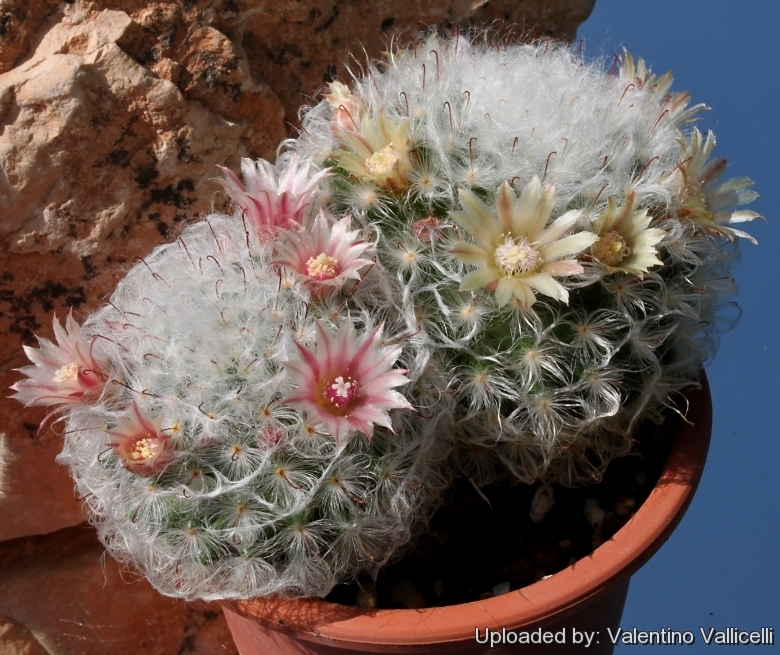
has round soft stems with an extreme abundance of white woolly hairs and short hooked central spines.
Origin and Habitat: Garden origin (Nursery produced cultivar)
Synonyms:
Mammillaria bocasana Poselg.
Allg. Gartenzeitung (Otto & Dietrich) 21: 94. 1853
Synonymy: 13
- Mammillaria bocasana Poselg.
- Cactus bocasanus (Poselg.) J.M.Coult.
- Chilita bocasana (Poselg.) Orcutt
- Ebnerella bocasana (Poselg.) Buxb.
- Krainzia bocasana (Poselg.) Doweld
- Neomammillaria bocasana (Poselg.) Britton & Rose
- Mammillaria haehneliana Boed.
- Chilita haehneliana (Boed.) Buxb.
- Ebnerella haehneliana (Boed.) Buxb.
- Mammillaria seideliana Quehl
- Chilita seideliana (Quehl) Orcutt
- Ebnerella seideliana (Quehl) Buxb.
- Neomammillaria seideliana (Quehl) Britton & Rose
Mammillaria bocasana subs. eschauzieri (J.M.Coult.) W.A.Fitz Maur. & B.Fitz Maur.
J. Mammillaria Soc. 35(2): 17 (1995) (also spelled: "eschanzieri" or "eschausieri")
Synonymy: 27
- Mammillaria bocasana subs. eschauzieri (J.M.Coult.) W.A.Fitz Maur. & B.Fitz Maur.
- Cactus eschauzieri J.M.Coult.
- Chilita eschanzieri (J.M.Coult.) Orcutt
- Krainzia bocasana subs. eschauzieri (J.M.Coult.) Doweld
- Mammillaria eschauzieri (J.M.Coult.) R.T.Craig
- Neomammillaria eschauzieri (J.M.Coult.) Britton & Rose
- Mammillaria bocasana f. hirsuta Boed.
- Chilita hirsuta (Boed.) Orcutt
- Mammillaria hirsuta Boed.
- Neomammillaria hirsuta (Boed.) Britton & Rose
- Mammillaria bocasana var. kunzeana (Boed. & Quehl) Quehl
- Chilita kunzeana (Boed. & Quehl) Orcutt
- Ebnerella kunzeana (Boed. & Quehl) Buxb.
- Mammillaria kunzeana Boed. & Quehl
- Neomammillaria kunzeana (Boed. & Quehl) Britton & Rose
- Mammillaria hirsuta var. grandis Repp.
- Mammillaria knebeliana Boed.
- Chilita knebeliana (Boed.) Buxb.
- Ebnerella knebeliana (Boed.) Buxb.
- Mammillaria longicoma (Britton & Rose) A.Berger
- Chilita longicoma (Britton & Rose) Orcutt
- Ebnerella longicoma (Britton & Rose) Buxb.
- Neomammillaria longicoma Britton & Rose
- Mammillaria longicoma var. flavispina. Y.Itô
- Neomammillaria longicoma var. flavispina (Y.Itô) Y.Itô
- Mammillaria longicoma var. multiflora. Y.Itô
- Neomammillaria longicoma var. multiflora (Y.Itô) Y.Itô
- Mammillaria bocasana cv. Fred Standard Form
- Mammillaria bocasana cv. multilanata
- Mammillaria bocasana cv. multilanata f. cristata
- Mammillaria bocasana cv. roseiflora
- Mammillaria bocasana cv. splendens
- Mammillaria bocasana cv. splendens f. cristata
ENGLISH: Fishhooks, Powderpuff Cactus, Snowball Cactus, Powder Puff Cactus
SPANISH (Español): Cabeza blanca
Description: Mammillaria bocasana cv. multilanataSN|8970]]SN|15114]] is a selected cultivars densely covered by white woolly hairs similar to Mammillaria bocasana cv. splendensSN|15116]]SN|15116]] but not so woolly as the latter. It is commonly called the “Powder Puff Cactus”, because of its appearance like a cotton ball as the small round plant is covered with silky white hairs. Mammillaria bocasanaSN|15114]]SN|8970]] is quite variable with a lot of different varieties and forms available in cultivation. Generations of cactophiles have had this plant as one of their first acquisitions and few can have been disappointed by its easy cultivation and free-flowering habit.
Habit: it is a clumping cactus, often forming large mounds.
Stems: Individual stems spherical, sometimes b ecoming somewhat cylindrical. light green to bluish-green, 5-8(-12) cm tall and 3-6(-8) cm in diameter.
Tubercles: Slender, soft, cylindrical, terete, 6 to 8 mm long, their axil sometimes hairy or bristly. Without latex.
Radial spines: Numerous 50 or more, white, hair-like, silky, up to 20 mm long.
Central spines: 1-7, reddish brown, 5-10 mm long, much shorter than the radial hairy ones, of which one (occasionally two) hooked, brown, but paler at base.
Flower: Funnel-form, creamy-white, creamy-yellow or pinkish, 13-22 mm long, up to 15 mm in diameter, perianth-segments lanceolate-linear, acute, spreading. Flower-buds rose-coloured.
Blooming season: Spring and summer.
Fruits: Cylindrical, rosy-pink to red, 2,5 cm long in summer.
Seeds: Reddish brown, with partially lateral hilum.
Subspecies, varieties, forms and cultivars of plants belonging to the Mammillaria bocasana group
 Mammillaria bocasana Poselg.: has 30-50 radial spines and red fruits. Distribution: San Luis Potosi.
Mammillaria bocasana Poselg.: has 30-50 radial spines and red fruits. Distribution: San Luis Potosi. Mammillaria bocasana subs. eschauzieri (J.M.Coult.) W.A.Fitz Maur. & B.Fitz Maur.: has 20-30 radial spines and pink fruits. Distribution: San Luis Potosi and Zacatecas.
Mammillaria bocasana subs. eschauzieri (J.M.Coult.) W.A.Fitz Maur. & B.Fitz Maur.: has 20-30 radial spines and pink fruits. Distribution: San Luis Potosi and Zacatecas.- Mammillaria bocasana f. hirsuta Boed.: same as: Mammillaria bocasana subs. eschauzieri
- Mammillaria bocasana var. kunzeana (Boed. & Quehl) Quehl
 Mammillaria bocasana cv. multilanata: has an extreme abundance of white wool-hairs and yellow flowers.
Mammillaria bocasana cv. multilanata: has an extreme abundance of white wool-hairs and yellow flowers. Mammillaria bocasana cv. multilanata f. cristata: has very wooly crested stems. Garden origin.
Mammillaria bocasana cv. multilanata f. cristata: has very wooly crested stems. Garden origin. Mammillaria bocasana cv. roseiflora: has bright pink blooms.
Mammillaria bocasana cv. roseiflora: has bright pink blooms. Mammillaria bocasana cv. splendens: similar to cv. multilanata but with an extreme abundance of short white woolly hairs and very short hooked central spines.
Mammillaria bocasana cv. splendens: similar to cv. multilanata but with an extreme abundance of short white woolly hairs and very short hooked central spines. Mammillaria bocasana cv. splendens f. cristata: crested form, completely covered by short white woolly hairs and very short hooked central spines.
Mammillaria bocasana cv. splendens f. cristata: crested form, completely covered by short white woolly hairs and very short hooked central spines. Mammillaria knebeliana Boed.: it is very similar (if not the same) to Mammillaria bocasana subs. eschauzieri . Ahualulco to Tinaja, and adjacent areas, San Luis Potosí.
Mammillaria knebeliana Boed.: it is very similar (if not the same) to Mammillaria bocasana subs. eschauzieri . Ahualulco to Tinaja, and adjacent areas, San Luis Potosí.
Bibliography: Major references and further lectures.
1) Robert T. Craig “The Mammillaria handbook: with descriptions, illustrations, and key to the species of the genus Mammillaria of the Cactaceae” E P Publishing, 1945
2) John Pilbeam “Mammillaria The Cactus File Handbook” Cirio Pub. Services, 01/Dec/1999
3) Edward Anderson “The Cactus family” Timber Press, Incorporated, 2001
4) James Cullen, Sabina G. Knees, H. Suzanne Cubey "The European Garden Flora Flowering Plants: A Manual for the Identification of Plants Cultivated in Europe, Both Out-of-Doors and Under Glass" Cambridge University Press, 11/Aug/2011
5) David R Hunt; Nigel P Taylor; Graham Charles; International Cactaceae Systematics Group. "The New Cactus Lexicon" dh books, 2006
6) Clive Innes, Charles Glass “Cacti” Portland House, 01/May/1991
7) N. L. Britton, J. N. Rose “The Cactaceae. Descriptions and Illustrations of Plants of the Cactus Family.” Volume 4, The Carnegie Institution of Washington, Washington 1923
8) Gurcharan Singh Randhawa, Amitabha Mukhopadhyay “Floriculture in India” Allied Publishers, 01/Jan/1986
9) Anne Swithinbank “The Greenhouse Gardener” frances lincoln ltd, 2006
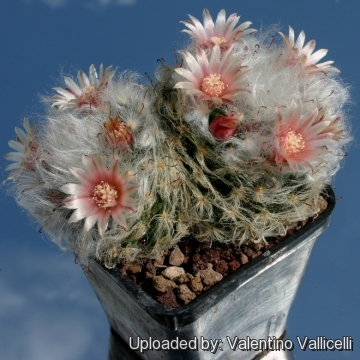
Mammillaria bocasana var. multilanata (Mammillaria bocasana cv. multilanata) Photo by: Valentino Vallicelli
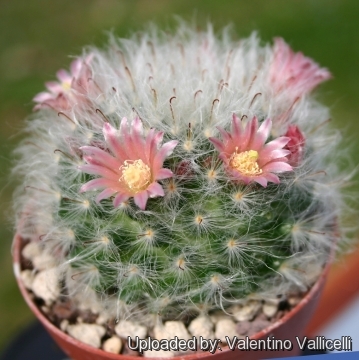
Mammillaria bocasana var. multilanata (Mammillaria bocasana cv. multilanata) Photo by: Valentino Vallicelli
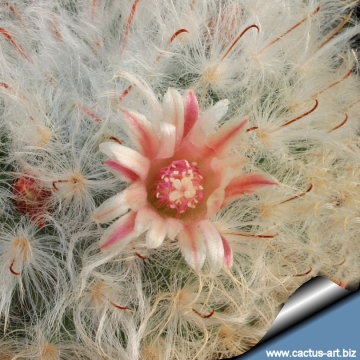
Mammillaria bocasana var. multilanata (Mammillaria bocasana cv. multilanata) Photo by: Cactus Art
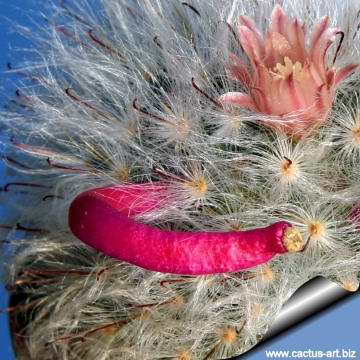
Mammillaria bocasana var. multilanata (Mammillaria bocasana cv. multilanata) Photo by: Cactus Art

Mammillaria bocasana var. multilanata (Mammillaria bocasana cv. multilanata) Photo by: Cactus Art

Mammillaria bocasana var. multilanata (Mammillaria bocasana cv. multilanata) Photo by: Valentino Vallicelli
Cultivation and Propagation: Mammillaria bocasana cv. multilanataSN|15114]]SN|15114]] is a freely clustering species that reproduces easily by cutting. It is a great starter plant for the cactus grower, that readily builds up into a dense cluster of stems smothered by white hairs, further decorated by rings of cream or pale pink blooms, it doesn't require any special treatment. If grown correctly, it will reward the grower with generous displays of flowers.
Growth rate: It is a rapidly growing species. It offset from the base and can fill a 25 cm pot in just a few years given the best conditions.
Soils: It likes very porous standard cactus mix soil with little organic matter (peat, humus).
Repotting: Repotting every 2-3 years. For best results, use a shallow pot filled with very porous compost, and only use the smallest diameter pot that will accommodate the plant. Use pot with good drainage.
Watering: Water regularly in summer, but do not overwater. Its roots are easily lost in pots that stay damp for any length of time. Additionally, water should not be applied from above, as the wolly spines will retain water and add to rotting problems, but in good conditions with excellent ventilation, in bright light, it usually grows without particular difficulty. Keep dry with ample airflow in winter. In the rest period no high atmospheric humidity!! Care must be taken with watering as they tends to become swollen and untidy in growth habit if given too much water and shade.
Fertilization: During the growing season enrich the soil using a fertilizer rich in potassium and phosphorous, but poor in nitrogen, because this chemical element doesn’t help the development of succulent plants, making them too soft and full of water.
Hardiness: It is quite frost resistant if kept dry, hardy as low as -5° C (some reports give it hardy to -12°C). However some warmth throughout the year will increase the grower's success (minimum 5° to 8°C during rest season).
Sun Exposure: Outside bright sun, filtered sunlight or afternoon shade, inside it needs bright light, and some direct sun. High levels of light are needed to flower and for good spine development. Can be sunburned if moved from shade/greenhouse into full sun too quickly. During the spring it may be able to take full sun until the heat arrives at the end of spring. In an area that has hot afternoon sun, it may be able to take full morning sun, but requires afternoon shade or afternoon light shade.
Uses: It is an excellent plant for container growing. It always looks good and stays small. It look fine in a cold greenhouse and frame.
Traditional uses: The white, hooked spines of this spherical cactus were used as fish hooks in its native Mexico.
Pests & diseases: It may be attractive to a variety of insects, but plants in good condition should be nearly pest-free, particularly if they are grown in a mineral potting-mix, with good exposure and ventilation. Nonetheless, there are several pests to watch for:
- Red spiders: Sensitive to red spider mite. Overhead watering is helpful in controlling mites.
- Mealy bugs: Occasionally mealy bugs they develop aerial into the new growth among the wool with disfiguring results, but the worst types develop underground on the roots and are invisible except by their effects.
- Scales: Scales are rarely a problem.
- Rot: Rot it is only a minor problem with cacti if the plants are watered and “aired” correctly. If they are not, fungicides won't help all that much.
Propagation: Direct sow after last frost or (usually) or division . Seeds germinate in 7-14 days at 21-27° C in spring, remove the glass cover gradually as the plants develops and keep ventilated, no full sun for young plants! The seedlings should not be disturbed until they are well rooted, after which they can be planted separately in small pots. Cuttings: wait until the offsets that appear at the base of old clustered specimens are 1/3 the size of the parent and then detach and plant. Cuttings will take root in a minimum temperature of 20° C (but better in hot weather). Cuttings of healthy shoots can be taken in the spring and summer. Cut the stem with a sharp, sterile knife, leave the cutting in a warm, dry place for a week or weeks (depending on how thick the cutting is) until a callus forms over the wound. Once the callus forms, the cutting may be inserted in a container filled with firmed cactus potting mix topped with a surface layer of coarse grit. They should be placed in the coarse grit only; this prevents the cut end from becoming too wet and allows the roots to penetrate the rich compost underneath. The cuttings should root in 2 to 6 weeks.
| Your Actions | |
|---|---|
| Back to Mammillaria index | |
| Back to Cactaceae index | |
 |
Back to Cacti Encyclopedia index |
Privacy stantement - Terms and conditions - How to cite - About us - Feedback - Donate



